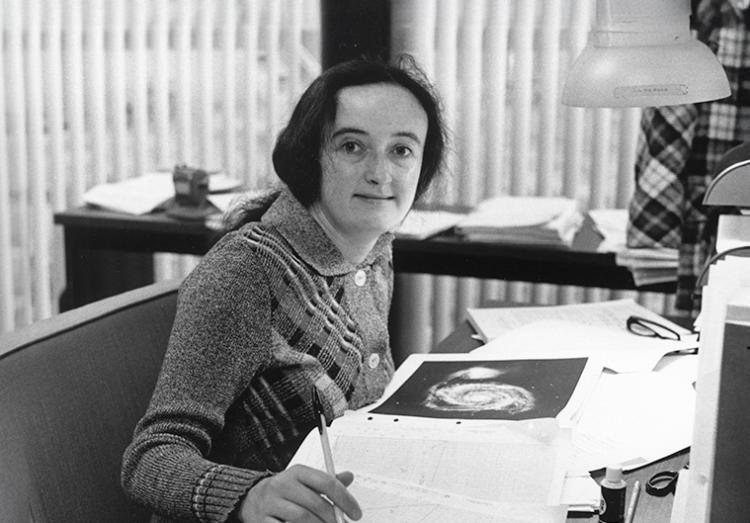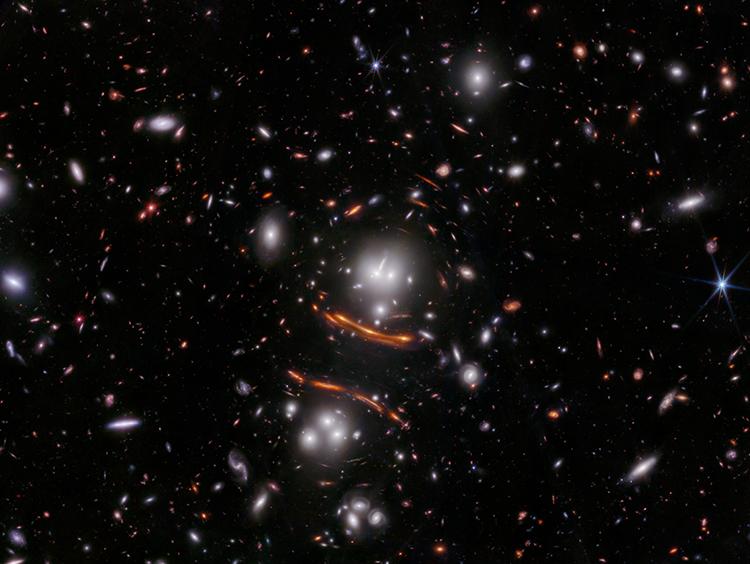In New Zealand, a mountain bears her name; in space, an asteroid. Worldwide, she is celebrated for her paradigm-shifting discoveries about the evolution of galaxies. At Yale, Beatrice Tinsley is also remembered as the university’s first female professor of astronomy. She taught from 1975 until her death from cancer in 1981, at the age of 40.
“Beatrice Tinsley is an inspiration to us all,” says Priyamvada Natarajan, the Joseph S. and Sophia S. Fruton Professor of Astronomy and Physics and chair of the Department of Astronomy. “Her papers showing that properties of galaxies change over time were way ahead of their day. Galaxy formation and evolution are now important sub-fields at the frontier of astronomy research, thanks to data made possible by new telescopes. Tinsley prepared the ground for much of this work.”
This past fall, Natarajan teamed up with Larry Gladney, FAS Dean of Science and the Phyllis Wallace Dean of Diversity and Faculty Development, to launch Yale’s inaugural Tinsley Workshop, a symposium for early- and mid-career faculty to present their cutting-edge research. Co-sponsored by the Department of Astronomy, the Physics Department, and the Yale Center for Astronomy and Astrophysics, the Tinsley Workshop was made possible by a generous grant from Heising-Simons Foundation.
“This funding was pivotal,” says Natarajan. “Heising-Simons Foundation is highly regarded within the physical sciences as an organization that not only supports fundamental scientific research but also provides vital mentorship training, networking, and professional development opportunities for early- and mid-career scientists, especially for those who are traditionally under-represented in these fields. With this funding, we were able to make the conference a real opportunity to showcase the work of talented scientists at a critical point in their careers.”

Cosmic Origins
To plan the inaugural workshop, Natarajan assembled a scientific organizing committee comprised of Pieter van Dokkum, the Sol Goldman Family Professor of Astronomy and Physics, and two postdoctoral fellows, Colin Burke and Antonio Porras Valverde. They decided to focus the symposium on new findings from the James Webb Space Telescope (JWST) relating to galaxies and black holes in the early universe, a fitting commemoration of Tinsley’s intellectual legacy.
As with other telescopes like the Hubble, scientists from anywhere in the world can apply for time to collect data using the JWST. But now research proposals are evaluated using a dual-anonymous review process, meaning that decision-makers focus on the scientific merit of a proposal rather than who submitted it. This change, which Natarajan was involved in implementing, has significantly reduced gender discrepancy in acceptance rates and has put new and established researchers on a more equal footing.
“Since its launch in 2021, the JWST has produced an explosion of new observations and data that are helping us to answer big open questions about early galaxy formation,” Natarajan explains. “Younger scientists have been writing fantastic proposals and are driving many of these discoveries forward.”

The Right Energy
The Tinsley Workshop brought together more than seventy scientists to the top floor of Kline Tower to present findings from their research, surrounded by sweeping views of Yale’s campus and New Haven. Among the attendees were graduate students, post-docs, junior faculty, and tenured faculty, from institutions across the US and in Europe, including Yale, UC Berkeley, the University of Texas at Austin, MIT, Princeton, Rochester Institute of Technology, UConn, Cambridge, and the University of Geneva, among several others.
“The success of any cutting-edge science workshop is measured by how many people show results that are not yet published,” says Natarajan. “At the Tinsley Workshop, there were so many unpublished results that we did not record the talks or ask presenters for their slides. These were hot-off-the-press findings.” Symposium talks were kept short to allow all participants the opportunity to present with ample room for discussion.
“In my opinion, nothing is better for promoting people in scientific careers than giving them a chance to be on a big stage—but not such a huge stage that it’s too frightening to actually speak,” says Gladney.
The “just right” size of the workshop encouraged interaction between participants and allowed for plentiful networking opportunities. An evening panel on mentoring and career development featured five of the workshop speakers and ran well beyond its allotted time due to an enthusiastic Q&A session.
“There was a great deal of collegial engagement throughout the conference that was very much in the spirit of curiosity and learning,” says Natarajan. “We wanted the workshop to provide a shot of inspiration, and it seems to have done its job.”
For Inclusivity
That shot of inspiration also reached those outside the scientific community. An essential element of the Tinsley Workshop involves bringing a leading expert to campus to give a public keynote lecture related to the topic of the symposium.
“We took the accessibility and reach of the science discussed at the Tinsley Workshop very seriously and recognized the importance of a public component,” says Natarajan.
Dr. Jane Rigby, an astrophysicist at the NASA Goddard Space Flight Center and the senior project scientist for the JWST, spoke to a full audience from the greater New Haven area about the breadth and depth of the JWST science program. Rigby detailed the international, collective effort of 20,000 people to build the telescope over the course of more than two decades and discussed what its awe-inspiring views of deep space have already revealed to us about the universe—and what future discoveries may await.
A Glimpse Ahead
The endowment from Heising-Simons Foundation will help support future Tinsley Workshops in the coming years, each one focused on a different emerging topic in the physical sciences. “Wherever the frontiers of physical science take us, that is where the next workshops will go,” says Gladney.
